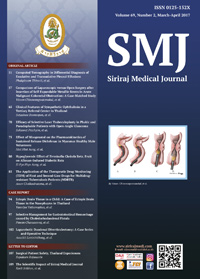Comparison of Laparoscopic versus Open Surgery after Insertion of Self-Expandable Metallic Stents in Acute Malignant Colorectal Obstruction: A Case-Matched Study
Keywords:
Self-expanding metallic stent (SEMS), malignant colorectal obstruction, laparoscopic, bridge to surgery, primary anastomosis, ostomyAbstract
Background: Self-expanding metallic stents (SEMS) have been acknowledged in management of acute colorectal obstruction. The surgical approach after SEMS insertion varies from open approach to laparoscopic-assisted approach. The primary objective of this study was to compare the outcomes of laparoscopic approach and open approach after SEMS insertion.
Methods: From January 2007 to December 2010, cross-sectional medical records reviewed a total of 76 patients who underwent colorectal stenting with SEMS. Patients and tumor characteristics, complications, morbidity and mortality were obtained.
Results: Forty-three patients underwent SEMS placement as a bridge to surgery. Laparoscopic-assisted surgery (LS) was performed in 24 patients (55.8%), and open surgery (OS) was performed in 19 patients (44.2%). All clinicopathological parameters were matched. The technical success of SEMS was found in 42 patients (97.7%), and the clinical stent success was 100%. LS had a higher chance of primary anastomosis than OS (p=0.012; Odd ratio 2.717; 95%CI: 1.79-4.012). LS had a lower permanent ostomy rate (p=0.031; Odd ratio 0.385; 95%CI: 0.259-0.572) and lower estimated blood loss (p=0.024; Odd ratio 0.23; 95%CI: 0.006-0.086). The post-operative complications, mortality rate, recurrence rate, disease free status, and overall survival rates between the two groups were non-significant.
Conclusion: Colonic stent is an effective treatment of acute malignant colonic obstruction. The authors suggest the advantage of laparoscopic approach resection after colonic stenting results in a higher primary anastomosis rate, and lower blood loss than open surgery.
Downloads
Published
How to Cite
Issue
Section
License
Authors who publish with this journal agree to the following conditions:
Copyright Transfer
In submitting a manuscript, the authors acknowledge that the work will become the copyrighted property of Siriraj Medical Journal upon publication.
License
Articles are licensed under a Creative Commons Attribution-NonCommercial-NoDerivatives 4.0 International License (CC BY-NC-ND 4.0). This license allows for the sharing of the work for non-commercial purposes with proper attribution to the authors and the journal. However, it does not permit modifications or the creation of derivative works.
Sharing and Access
Authors are encouraged to share their article on their personal or institutional websites and through other non-commercial platforms. Doing so can increase readership and citations.











